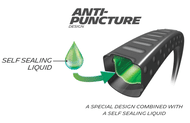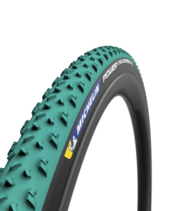
Tips and advice bicycle
A bike puncture is the dread of most cyclists. But over the years, progress has been made in this area and the risk of a bike puncture can be reduced by taking a few precautions. Discover the tips and tricks from our experts to ride your bike with greater peace of mind.
The 3 types of bike punctures
You may not know it yet: there are three types of bike punctures to which your bicycle tyres are exposed. And for each one we share our recommendations.
1 - Perforation and cuts
Nails, stones, thorns, etc. may be the cause of perforation of the inner tube or tubeless tyre. The aggressive nature of the components of some road surfaces can also give rise to cuts.
The thickness and quality of rubber, the density of the casing cords and the presence of a textile reinforcing ply are factors which affect the tyre's resistance to these bike punctures.
The type of inner tube used also has an effect: nature of the rubber, thickness and the presence of a self-sealing liquid.
How to prevent perforation and cuts?
If you are using Tubetype, Michelin recommends MICHELIN PROTEK MAX inner tubes for Mountain Bikes in particular and for urban use and city trekking.
Its special design combined with a self sealing liquid ensures a good bike puncture protection.

MICHELIN Protek Max inner tubes ensure good puncture protection
2 - Pinch puncture
This kind of bike puncture happens when the inner tube is pinched between the rim flange and the ground when passing over an obstacle at high speed (a pothole, for example).
How to prevent pinch puncture?
We advise you to ensure that the tyre pressure is always as recommended by the manufacturer.
Also note that a tyre with a wide cross-section, thick sidewall and a thick-walled inner tube can resist this type of pinching, such as those in the MICHELIN Power range.
3 - Perforation by the rim wall
This type of perforation occurs when the rim tape is unsuitable (width, material, incorrect centring, etc.) or in poor condition. This type of perforation is identified by the position of the hole in the tube, which is on the rim side, not on the tread side.
How to prevent perforation by the rim wall?
To avoid this type of bike puncture, we recommend changing the rim tape each time a tyre is replaced, as we do for new inner tubes.

The risk of bike puncture can be reduced by taking a few precautions
Equip yourself with puncture-resistant bike tyres
While the above precautions can reduce the risk of a bike puncture, you can also opt for greater peace of mind for your rides on the road by equipping yourself with puncture-resistant road tyres.
Our MICHELIN Power range has been precisely designed to meet all your needs and to offer you strong resistance to bike punctures.

MICHELIN POWER ALL SEASON

Maintain maximum grip in all weather conditions
View this tyre

MICHELIN POWER CYCLOCROSS JET

The cyclocross tyre with tubular performance(1)
View this tyre

MICHELIN POWER CYCLOCROSS MUD

Responsive traction on muddy terrain
View this tyre

MICHELIN POWER CUP COMPETITION LINE


Inspire your confidence with the MICHELIN Power Cup tyre for racing and training
View this tyre

MICHELIN POWER ADVENTURE COMPETITION LINE

Enjoy freedom beyond the road with the MICHELIN Power Adventure Tyre
View this tyre

MICHELIN POWER CYCLOCROSS JET TUBULAR

Designed to finish on the podium
View this tyre
Find the right tyre
Enter your Reg, vehicle or tyre size
We're searching for your tire...
Wait few seconds we're processing your photo

